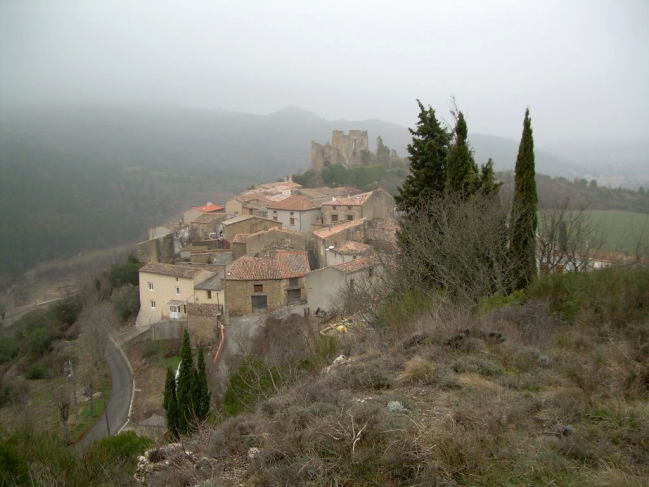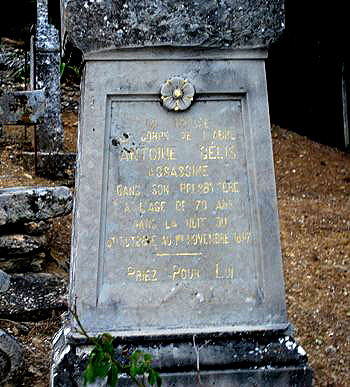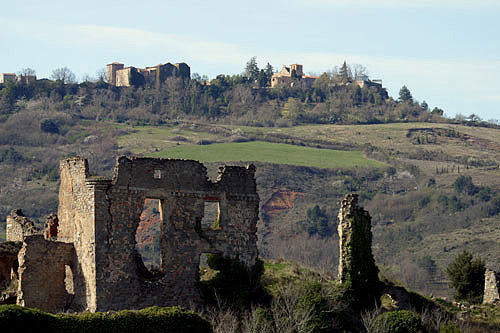Who Killed Antoine Gélis?
Who Killed poor Gélis? Qui a tué le pauvre Gélis?
This is one of the great mysteries of Rennes-le-Château but I believe I have solved it!
Antoine Gélis was the priest of Coustaussa, across the valley of the Sals from Rennes-le-Château and was a close friend of Bérenger Saunière. He was born in April 1827 and had been the curé of Coustaussa since 1857. His grave, with what is said to be a Rosicrucian cross, can still be seen in the graveyard there, about two-thirds of the way up It was in danger of falling when this picture was taken in 1996. As well as Rosicrucianism, he is said to have been interested in Gnostic dualism.

Coustaussa on a misty day. (Photo Keith Ashby.) Gélis's tombstone
He was assassinated brutally on the night of October 31/November 1 in 1897. The bloody body of the priest was found the next day - All Saint's Day.
The police were baffled; the old priest always checked visitors and had a chain-lock on the door, so he must have known his murderer. No one in the village had heard any noises and certainly no screaming. The autopsy proved he had been hit by the heavy fire-tongs and then with an axe. He had fourteen wounds to the head and multiple skull fractures.
Once he was dead, his murderer had laid him flat and crossed his arms across his chest - the work of a churchman? The French report uses the word "gisant", meaning, "lying as though in the tomb." On the table was a bottle of Banyuls, another one of Porto, and packet of cigarettes, but Antoine Gélis did not smoke. On the packet was written "Viva Angelina."
No money was taken, although immense amounts were scattered around the house; but the presbytère had been ransacked, the lock of the deed box had been forced, satchels of papers had been rifled through and some taken. We can only speculate what papers they were.
(This theme - papers, documents - runs all the way through my book "Mary, Jesus and the Charismatic Priest." Click here to find out more.)
The next morning, All Saints Day, the priest's nephew arrived, probably to borrow money because his grandson had been born at nearby Luc. He went into the house to open the shutters - and stumbled over the body. He ran out into the street and fell over in a dead faint. Later he was accused of the murder, but they found no case whatsoever against him.
Eight years previous to the murder, a meeting had been held at Gélis's home, as was noted in Bérenger's diary, on 29th September 1891. Henri Boudet was there, from Rennes-les-Bains, and also Guilliame Cros, often described as Bishop Billard's "secretary." In fact, Cros was one of the four Deacons of Bishop Billard. His official title was Deacon of Castelnaudary and Limoux, second in command after the Deacon of Carcassonne and Narbonne. Cros had been appointed in 1881 and re-appointed in 1887 and 1892, but always as the second Deacon.
The story of the meeting is recounted in Jean-Luc Robin's book about Rennes-le-Château (see our Book Reviews.) It says; "Billard had sent his secretary . . . in order to deliver a sealed package . . it seems to be a bundle of documents . . . they took good care not to open it in his presence and Gélis put it away upstairs before they sat down to lunch."
Bérenger Saunière thanked Cros, asking him to tell the Bishop the papers would be well looked after. The midday meal then apparently impressed Cros with its sumptiousness. The implication is that Cros was poor; he and Boudet knew each other because they had been brought up together in Axat, and they both went into the Church. Cros was the son of a schoolteacher who had, apparently, progressive ideas, at the time that meant, tending towards Republicanism. Cros's father, a non-believer, pushed his son into the church to give him a career and a social position.
It was Jean-Luc Robin's theory that Cros was envious of the others, and later reported back to Billard's successor, Beausejour, the Republican bishop who was appointed in 1902, about Bérenger's activities, which was one of the reasons why Beausejour harrassed Bérenger so much.
But by 1891 Cros had lost his job as Deacon. In the official list published in 1889 he has simply disappeared; he was no longer Deacon. So what happened to him? I can find no mention of him anywhere. He did not serve under Beausejour, and he was not serving under Billard in 1891.
The meeting at Coustaussa in September took place 8 days after Bérenger Saunière had written laconically in his diary on the 21st - "letter from Granes, discovery of a tomb, rain." BUT on the 29th Bérenger wrote; "Saw the curé of Névian - Gélis's place - Carrière's place - saw Cros and Secret." There is no mention of Boudet or lunch. Saunière listed his expenses as "going to Luc." (Luc-sur-Aude.) Cros was last on his list and it seems (l'Héritage de l'Abbé Saunière by Claire Corbu and Antoine Captier) "that the two priests were discussing the discovery made at Rennes and they would decide to guard the secret."
In other places in his diary Bérenger mentions "four brothers" - the French word used is "confréres" - implying more than being colleagues, but being members of a society of brotherhood - there's more than a hint of freemasonry here, because the "four zealous brothers" is a freemasonry concept. On the 6th October, Bérenger received a visit from "four brothers". We can conclude, I think, that these included the mysterious Carrière that he met on the same day that he met Cros at Luc-sur-Aude - or, it could mean that Saunière, Boudet, Gélis and Cros considered themselves "four zealous brothers."
After Gélis was murdered Saunière received many letters (says Claire Corbu) but not one of them was found after Saunière died and he made no note of them in his diary. But he did become very paranoic; I think he knew something of what had happened. I think he knew who had murdered Gélis. And why.
The old man had taken a long time to die. The murder was the act of a man who wanted something and was determined to get it, but it was not the act of a murderer but someone who, in fact, did not know how to kill anyone.
Someone arrived, between 9pm and midnight, to see Gélis, and Gélis knew him, so he let him in. They sat down and drank together; then the visitor got up, picked up the firetongs, and hit Gélis over the head from behind (The autopsy re-constructed this.) The old man got up to go to the window to shout for help. The attacker realised that Gélis would talk if it was left there. Secrets would be revealed. Panicking, he returned to the fireplace and picked up the "hachette", a small axe probably used to split logs for the fire. Once he had gone that far, the murderer was desperate enough to attack and attack until the priest was dead.
Who did Gélis know that Saunière knew? Who could it have been that the police never thought of and that the Church (who, according to Robin, did their own investigations) never thought of?
I think Saunière and some of the others had argued with Cros and tried to cut him out of any share of the treasure, whether it was money or religious secrets. Cros had lost his position as a churchman. He had been told the secret was in Gélis's house - Gélis refused to co-operate - things went too far. Saunière and Boudet knew Cros had done it; but if they said anything, they would have lost their church positions because of their freemasonry and Cros, and maybe even other freemasons, would have come after them as well.
After that, Saunière and Boudet took very great care about who they invited into their houses or even their villages . . . and their own friendship was shattered.
And the words "Viva Angelina"? The priests used to do word puzzles that were popular at the time, and to crack the code a phrase was used for each puzzle. "Viva Angelina" was such a code. Apparently, nobody at the time thought to check the handwriting against that of anybody involved. I wonder why?
Inscrivez-vous au blog
Soyez prévenu par email des prochaines mises à jour
Rejoignez les 97 autres membres



